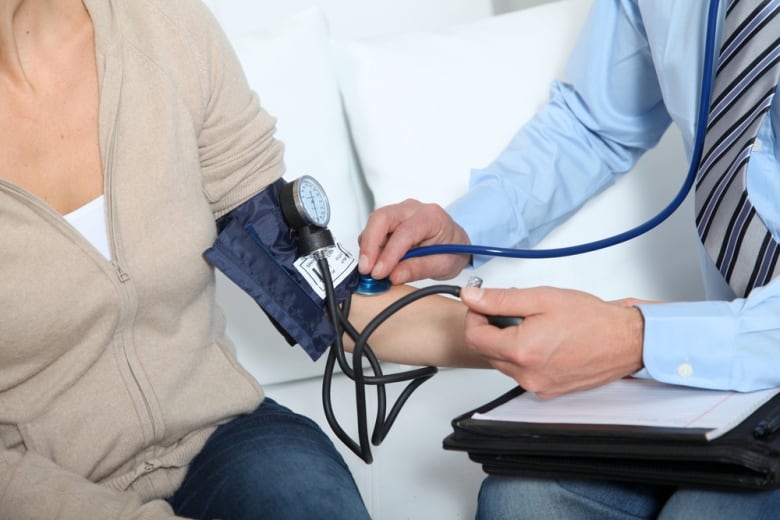[ad_1]
Every 22 minutes, a woman in Canada dies of a heart attack.
But the majority don’t have to, experts say, warning that more women will die unnecessarily if the medical community doesn’t tailor care to their needs.
“We have one of the best health-care systems in the world, and we’re not serving women,” said Dr. Paula Harvey, a cardiologist and head of the department of medicine at Women’s College Hospital in Toronto. “We have to do better.”
Heart disease is a top killer of women in Canada, and the push to change that is more urgent than ever. Harvey says more younger women are presenting with classic high risk factors for heart disease: high blood pressure, diabetes and obesity.
“There’s this trend to cardiovascular risk factors starting to be a problem at an earlier age, and I find that disturbing,” said Harvey. “I never used to see a woman in her 40s with high blood pressure. I’m starting to see that, and that’s going to mean that we’ll have more premature heart disease.”

How hormone levels affect heart health
Some studies have already found the heart attack rate among women aged 35-54 has gone up.
Lifestyle factors play a role in the trend, but the threat itself is broader — the majority of Canadian women have at least one risk factor for cardiovascular disease. Women with diabetes and those who come from certain racial or ethnic backgrounds are at higher risk, but fluctuating hormones can wreak havoc with any woman’s heart health, especially as they enter menopause and levels of the heart-protecting hormone, estrogen, start to drop.
That transition starts when women are in their 40s and can catch many off guard, Harvey said.
“I do think that a lot of that comes from the fact that women are still not being educated, they’re not being counselled, they don’t understand the impact of our changing biology with age that puts them at cardiovascular risk.”
Heart disease kills 5 times more women than breast cancer
According to the Canadian Women’s Heart Health Centre, at the University of Ottawa Heart Institute, 24,000 Canadian women die of heart disease every year. That’s nearly five times more deaths than from breast cancer.
Yet when it comes to heart health, experts say it’s still largely a man’s world: Women remain underdiagnosed, undertreated and unaware.

“It is a glass ceiling. It’s a glass ceiling for awareness, it’s a glass ceiling for research and for how we provide care,” said Karin Humphries, an associate professor at the University of British Columbia whose has researched gender and sex differences in the diagnosis, treatment and outcomes of patients with cardiovascular disease.
The basic medical model is still male-dominated and contributes to a general lack of awareness among women and health-care providers, Humphries said. And while awareness is growing, it’s not growing fast enough, she said.
“Everything in our culture emphasizes that cardiovascular disease is a man’s disease. I mean, think of Hollywood. Every time you see a heart attack, it’s on the male, right? You’re not watching a woman in a Hollywood movie having a heart attack.”
Heart attack symptoms more subtle in women
Part of the problem is that women’s symptoms can be different than those of men and can be attributed by both doctors and women themselves to stress and busy lives. For example, months before a heart attack, women may experience unusual fatigue, trouble sleeping, indigestion and anxiety.
Even during a heart attack, the symptoms can be subtle. Women are more likely to have chest discomfort, shortness of breath and even neck, jaw or back pain.

“I was still, you know, two months after my event, still reeling from that shock,” said Risa Mallory, who had a heart attack four years ago at age 61.
Mallory had been experiencing discomfort in her chest for several days, she said, but it came and went and didn’t seem so bad — until it suddenly was.
“On the fourth day, I experienced chest pain. It had changed. It was much more severe. I was feeling nauseous and I had this sense of fight or flight,” she recalled. “I remember sitting in the car, rocking, and saying, ‘We gotta go, we gotta go, we gotta go.'”
Mallory ended up in the emergency room and got help in time. But it was a close call. Heart disease runs in her family, she was aware of her own risk, but she still almost missed the warning signs.
A woman in Canada dies of heart disease every 22 minutes, and most don’t have to. CBC’s Ioanna Roumeliotis explores why so many women are underdiagnosed and what they can do to protect themselves.
That’s something that happens often, according to a 2018 Heart and Stroke Foundation report. The report found that early signs of a heart attack were missed in 78 per cent of women.
“What it tells us is that there are still a lot of inequalities and biases at the community level and the health-care provider level,” said Dr. Thais Coutinho, a cardiologist and chair of the Canadian Women’s Heart Health Centre at the University of Ottawa Heart Institute.
Many women are in the dark, Coutinho said, in large part because much of the medical community is too.
Most cardiac research done with male patients
Even now, the majority of heart disease research is conducted on men — despite important physiological differences, she said. Women’s hearts and arteries are smaller, and plaque builds in different ways. Standard diagnostic tests like angiograms and stress tests are often not sensitive enough to detect heart disease in women.
“That assumption still permeates through the cardiovascular research community that women are small men,” Coutinho said. “I do a lot of sex- and gender-based research, or women-specific cardiovascular research, and it’s amazing the differences that you find if you look. All of the gaps that we know exist from awareness, diagnosis, treatment, care, rehabilitation, education, everything — it starts with knowledge.
“So if we don’t even know what the differences are, we don’t know how to manage them.”
‘There’s something wrong with my heart’
Samia Janna was 48 when she first went to her doctor in 2018 because of shortness of breath. The Ottawa-area woman was prescribed anti-anxiety medication and told to take it easy. But the symptoms persisted.
Janna went back to her doctor twice more, only to be given the same advice.
“At that time, I said, ‘No, I know it’s not anxiety,'” Janna says. “I know myself. There’s something wrong with my heart.”

Blood tests didn’t flag anything, but Janna insisted on an ultrasound to check her heart. It revealed Janna’s heart was enlarged and causing damage to her heart valves. She ended up having two open heart surgeries.
Janna says it was hard to let go of her anger about the fact that her concerns were initially dismissed. She joined a cardiac rehabilitation program and says it helped her regain her physical and emotional strength. “If it wasn’t for them. I would have been in a different place now, in a very dark place.”
Female patients less likely to get cardiac rehab
Cardiac rehabilitation can be critical for physical and emotional recovery, studies show — but gaps exist there too.
Research finds women are up to 50 per cent less likely than men to attend cardiac rehab programs, often because they don’t get referred to one or face other barriers to follow-up care, including a tendency to minimize their own needs.
It helps explain why women who have a heart attack are more likely to die or experience a second heart attack compared to men.

Harvey says research is beginning to uncover the biological, medical, and social reasons for this — and the hope is that new knowledge will lead to advances in tailoring prevention and treatment to women’s needs.
But she points out, 80 per cent of heart attacks can be prevented and women can decrease major risk factors by managing high blood pressure, not smoking and sticking to a healthy weight. Harvey says women should also urge their doctors to check their hearts.
“We need to be empowered,” she says. “Knowledge is power. Advocacy is power. And do what you can so that you are aware of cardiovascular risk.”
And though prevention is key, Humphries says women should not hesitate to get help if they feel something is wrong.
“Call 911 and ask for help. Don’t worry about, you know, taking up time for health-care providers. They’re there to help you. And if you find out there’s nothing wrong with you, that’s wonderful. But absolutely do not hesitate and call 911.”
[ad_2]
Source link





